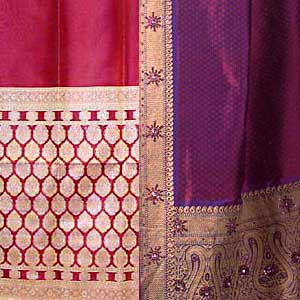| Chennai India | Transport | Chennai Real Estate | Home Issues | Education | Destination | Recreation | Chennai Hotels | Cars in India |
|
Shopping
Ranganathan Street
Chennai Shopping Malls
Jewelry shopping in Chennai
Silk Sari shopping in Chennai
Tissue Silk Sari
Silk Fabric Test
Chennai Entertainment
Pongal
December Festival
Chennai Birla Planetarium
Movie theaters in Chennai
Beaches
Muttukadu
Mahabalipuram
Marina Beach
Elliots Beach
Wildlife
Vandalur Zoo
Vedanthangal Bird Sanctuary
Chennai Snake Park
Crocodile Park Chennai
Amusement Parks
VGP Universal Kingdom
MGM Dizzee World
Queensland Amusement Park
|
Tissue Silk SareeThe sari is one of the oldest apparel in the world. The ancient Tamil epic ‘Silappadhikaram’ describes the exquisite beauty of the South Indian drapery of the women, namely the saree. Silk has always been a highly revered fabric in India. Silk is considered ceremonial wear at religious rituals and weddings. Silk is popular from time immemorial and it has been sought after by kings and queens. Silk is known for its softness, smoothness, and luster, graceful and sensuous folds, which lends itself to exquisite designing. Silk weaving tradition revolves around the saree, which is worn by women in most parts of India. A silk saree combines the glamour and shine associated with silk and creation of a myriad traditional saree styles associated with each region in India. Every kind of silk saree lends its unique flavor to the Indian ethnicity and cultural heritage. Silk saris are often created with zari work that is handcrafted using delicate gold threads. The pallu of a silk saree is normally adorned by intricate patterns usually made of zari. The border of the entire silk sarees normally contains zari work – the more the zari, the more expensive the saree. Indian silk saris Each saree is traditionally associated with the places where the sari originates. Each silk saree is recognized by its distinctive weave and texture, color, border width, pattern and motifs used and also the timeless heritage that a silk saree represents. While the North Indian silk sarees are largely influenced by the architectural patterns of Mughal periods, the south Indian silk sarees are intrinsically indigenous and ethnic. Tissue silk sari Benaras silk sari The Jamdani silk is a variety of brocade traditionally worn in Banaras. It is considered one of the finest silk products coming from the Banarasi loom. Jamevar and Navrangi are some of the other brocade types famous in Banaras silk sarees. The most famous is the Amru silk brocades known not only in India but abroad as well. Patola silk sari Bandhani silk saris The Panetar saree is a Gujarati saree of satin weave and Gajji silk with red borders. The most famous of this type of Gujarati saree is called Garchola. The Garchola is the traditional Hindu and Jain wedding saree, which nowadays are made of silk. The number of squares in the saree is ritually significant in multiples of 9,12 or 52. Paithani silk sari Chanderi and Maheshwari silks Tussar silk sari Embroidered tinsel sari Orissa Sambalpuri Sari Baluchari sari Apart from the above-mentioned silk sarees, Dharmavaram and Arani of Andhra Pradesh, Kornad of Tanjore, Kolegal, Molkalmoru and Mysore are other famous places for silk sarees in South India. All these sarees come in broad decorative borders, contrasting colors, traditional motifs and some in ikat silk weave. Each of these silk saree is an exquisite creation boasting of tradition and ethnicity atonce. Artificial silk sarees The artificial silk sarees are lightweight; they come in theme prints such as geometrical patterns, art, floral, figures and jungle print. They are available in a multitude of color options. There are casual sarees in artificial silk, which are lightweight and available in an array of colors and prints. The color schemes are vibrant, bold or subtle. They complement any skin color and personality. These sarees have all over print and scarcely any motifs. |

|
|
|
||